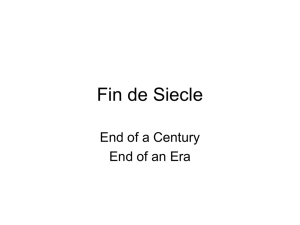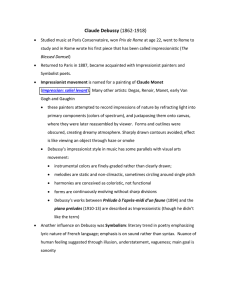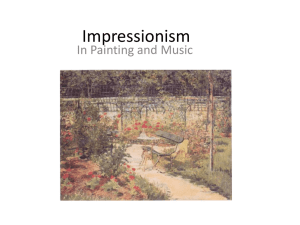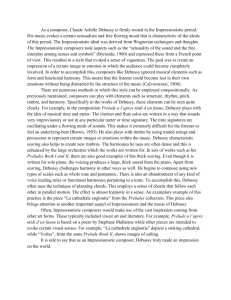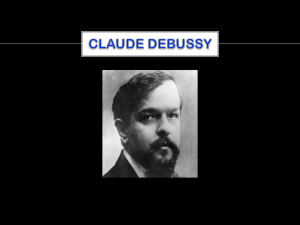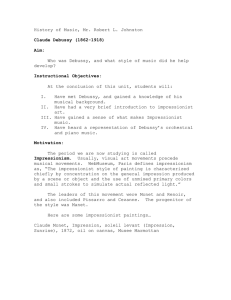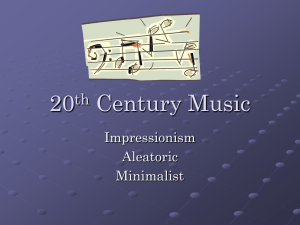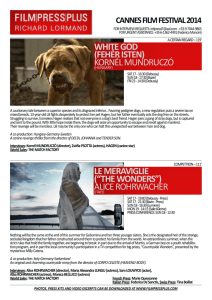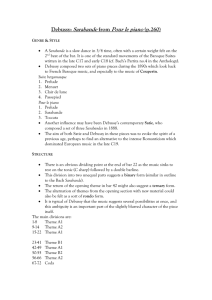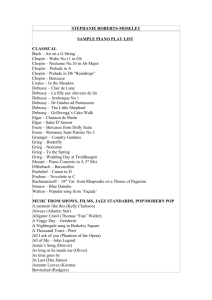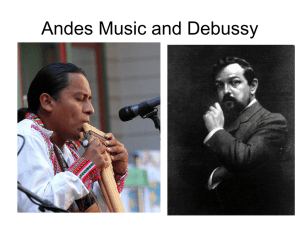Debussy and Impressionism
advertisement
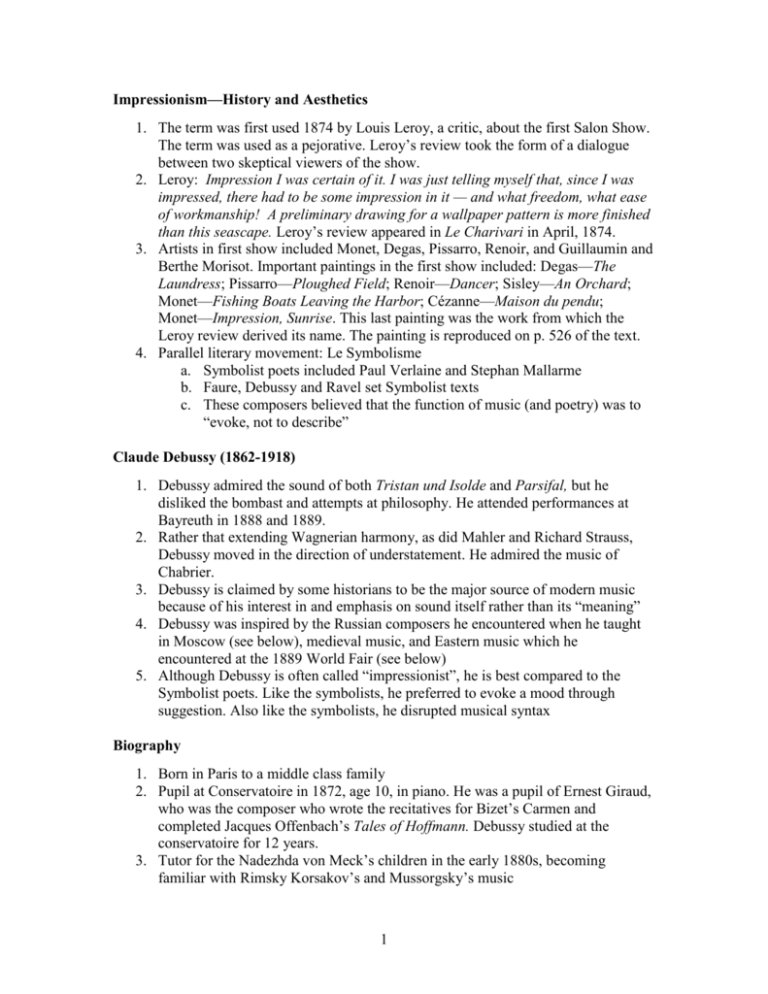
Impressionism—History and Aesthetics 1. The term was first used 1874 by Louis Leroy, a critic, about the first Salon Show. The term was used as a pejorative. Leroy’s review took the form of a dialogue between two skeptical viewers of the show. 2. Leroy: Impression I was certain of it. I was just telling myself that, since I was impressed, there had to be some impression in it — and what freedom, what ease of workmanship! A preliminary drawing for a wallpaper pattern is more finished than this seascape. Leroy’s review appeared in Le Charivari in April, 1874. 3. Artists in first show included Monet, Degas, Pissarro, Renoir, and Guillaumin and Berthe Morisot. Important paintings in the first show included: Degas—The Laundress; Pissarro—Ploughed Field; Renoir—Dancer; Sisley—An Orchard; Monet—Fishing Boats Leaving the Harbor; Cézanne—Maison du pendu; Monet—Impression, Sunrise. This last painting was the work from which the Leroy review derived its name. The painting is reproduced on p. 526 of the text. 4. Parallel literary movement: Le Symbolisme a. Symbolist poets included Paul Verlaine and Stephan Mallarme b. Faure, Debussy and Ravel set Symbolist texts c. These composers believed that the function of music (and poetry) was to “evoke, not to describe” Claude Debussy (1862-1918) 1. Debussy admired the sound of both Tristan und Isolde and Parsifal, but he disliked the bombast and attempts at philosophy. He attended performances at Bayreuth in 1888 and 1889. 2. Rather that extending Wagnerian harmony, as did Mahler and Richard Strauss, Debussy moved in the direction of understatement. He admired the music of Chabrier. 3. Debussy is claimed by some historians to be the major source of modern music because of his interest in and emphasis on sound itself rather than its “meaning” 4. Debussy was inspired by the Russian composers he encountered when he taught in Moscow (see below), medieval music, and Eastern music which he encountered at the 1889 World Fair (see below) 5. Although Debussy is often called “impressionist”, he is best compared to the Symbolist poets. Like the symbolists, he preferred to evoke a mood through suggestion. Also like the symbolists, he disrupted musical syntax Biography 1. Born in Paris to a middle class family 2. Pupil at Conservatoire in 1872, age 10, in piano. He was a pupil of Ernest Giraud, who was the composer who wrote the recitatives for Bizet’s Carmen and completed Jacques Offenbach’s Tales of Hoffmann. Debussy studied at the conservatoire for 12 years. 3. Tutor for the Nadezhda von Meck’s children in the early 1880s, becoming familiar with Rimsky Korsakov’s and Mussorgsky’s music 1 4. Won Prix de Rome in 1884. He found the atmosphere in Rome to be depressing. 5. Suffered from depression in early life 6. Visited Bayreuth in 1888 and 1889; impressions of Wagner were lasting. He “recognized the power of the music and his need to avoid being overly influenced by it” (Hanning). 7. Visit the Paris World Exposition in 1889, heard Javanese gamelan 8. Lived with Gabrielle Dupont (his lover) in Montmarte in the early 1890s 9. In 1898, after she left him, he married Lilly Texier, who was Dupont’s friend and a fashion model. Debussy eventually became dissatisfied with her lack of interest in music, art and other intellectual pursuits. 10. In 1903 he fell in love with Emma Bardac, who was the wife of a banker and the mother of one of his students. He left Texier in 1904, she became distraught over the Bardac affair and attempted suicide with a pistol. They had a child in 1905 and he married her in 1908. The child, Claude-Emma, was Debussy’s only child. She died in 1919 of diphtheria. 11. He was depressed by World War I 12. Diagnosed with cancer in 1914 13. Died in 1918. He survived surgery for colorectal cancer, having been one of the first patients to survive a colostomy operation. He died during the German bombardment of Paris. The Music 1. Harmonic and melodic resources and style a) Frequent use of parallel chords, sometimes called “streaming harmonies” or “chord streaming”. In this technique, triads, seventh and even ninth chords slide in parallel motion without regard to the key. The result is not harmony. b) Bitonal chords c) Whole-tone scales d) Pentatonic scales e) Octatonic scales f) Repetition will small changes rather than development g) Abrupt modulations, i.e., modulations without using a common tone h) Mathematical structures. Some writers have detected non-musical structures operating beneath the surface of Debussy’s music. For example, the Prelude to the Afternoon of a Faun has exactly as many measures of music as does the poem upon which it is based. i) Also, the Fibonacci number series and the Golden Mean have been detected in La Mer. 2. Prelude a l’apres-midi d’un faune (1891-94) a) Awakening of modern music dates from this score, according to Boulez b) Leonard Bernstein claimed in his Norton Lectures at Harvard that this work’s vague tonality laid the foundations of modern atonality. 2 c) The work was utilized by Nijinsky as a ballet score in 1912 with sets and costumes by Léon Bakst d) Refined orchestration. Scored for a smaller orchestra than the fashionable Wagnerian orchestra of the day. e) Emphasis on winds rather than strings f) Hint of gamelan (antique cymbals) g) Number of measures exactly equals number of lines of poetry in Mallarme poem. There is evidence that Debussy used Fibonnaci numbers in structuring his compositions. “Faun” is often described as a sonata form or an ABA, which fails to capture the way the work evolves in a series of developments (or improvisations) on musical cells. h) Debussy uses changing background technique which he learned from Russians i) Debussy’s description: “The music of this prelude is a very free illustration of Mallarme’s beautiful poem. By no means does it claim to be a synthesis of it. Rather there is a succession of scenes through which pass the desires and dreams of the faun in the heat of the afternoon. Then, tired of pursuing the timorous flight of nymphs and naiads, he succumbs to intoxicating sleep, in which he can finally realize his dreams of possession in universal Nature.” 3. Other significant works: a) Three Nocturnes (1897-99). A suite of three movements for orchestra (Nuages, Fêtes, Sirênes), the final movement with wordless women’s chorus. Nuages is in a modified ABA’ form. The oscillating pattern of thirds and fifths at the beginning was taken from a song by Musorgsky. b) Pelléas et Mélisande (1893-1902), opera. Based on a symbolist play by Maeterlinck. The story explores the interaction of love (eros) and revenge (anteros). It has been set to music repeatedly. Besides Debussy, incidental music to the play had already been written by Faure. Sibelius also wrote incidental music to the play, and Schoenberg wrote a symphonic poem. c) La Mer, three symphonic sketches (1903-1905). The cover art for the first edition used a popular print by Hokusai. d) Children’s Corner Suite (1906-08) dedicated to Emma-Claude who was born in 1905 e) Piano Preludes (1910)—a cycle of 12, often compared to Chopin f) The Martyrdom of Saint Sebastian (1910-11), incidental music to a play by D’Annunzio g) Etudes (1915) h) Jeux (1912-13) ballet for Serge Diaghilev’s Ballet Russes i) Violin Sonata (1917), which has neo-classical overtones j) Songs, string quartet. sonatas, chamber music 3
